Understanding Corporate Governance and Collapses: ACC03043 Report
VerifiedAdded on 2022/10/18
|6
|1379
|10
Report
AI Summary
This report, prepared for ACC03043, examines corporate governance and the reasons behind corporate collapses. It analyzes three key Australian cases: Alan Bond, Laurie Connell of Rothwells, and Girvan Corporation, exploring the underlying causes of their failures and whether current regulations could have prevented them. Additionally, the report delves into the corporate governance implications of the 2008 global financial crisis, investigating the failures of financial institutions, the role of flawed financial modeling, and the impact of irresponsible management. The report also discusses the changes in corporate governance regulations and the introduction of new responsibilities for management to prevent future crises. The analysis covers specific examples like Northern Rock Bank and the American International Group, highlighting the significance of board oversight and executive behavior. Finally, the report references the Corporations Act 2001 (Cth) and the Australian Stock Exchange's corporate governance principles, demonstrating the evolution of corporate governance practices.
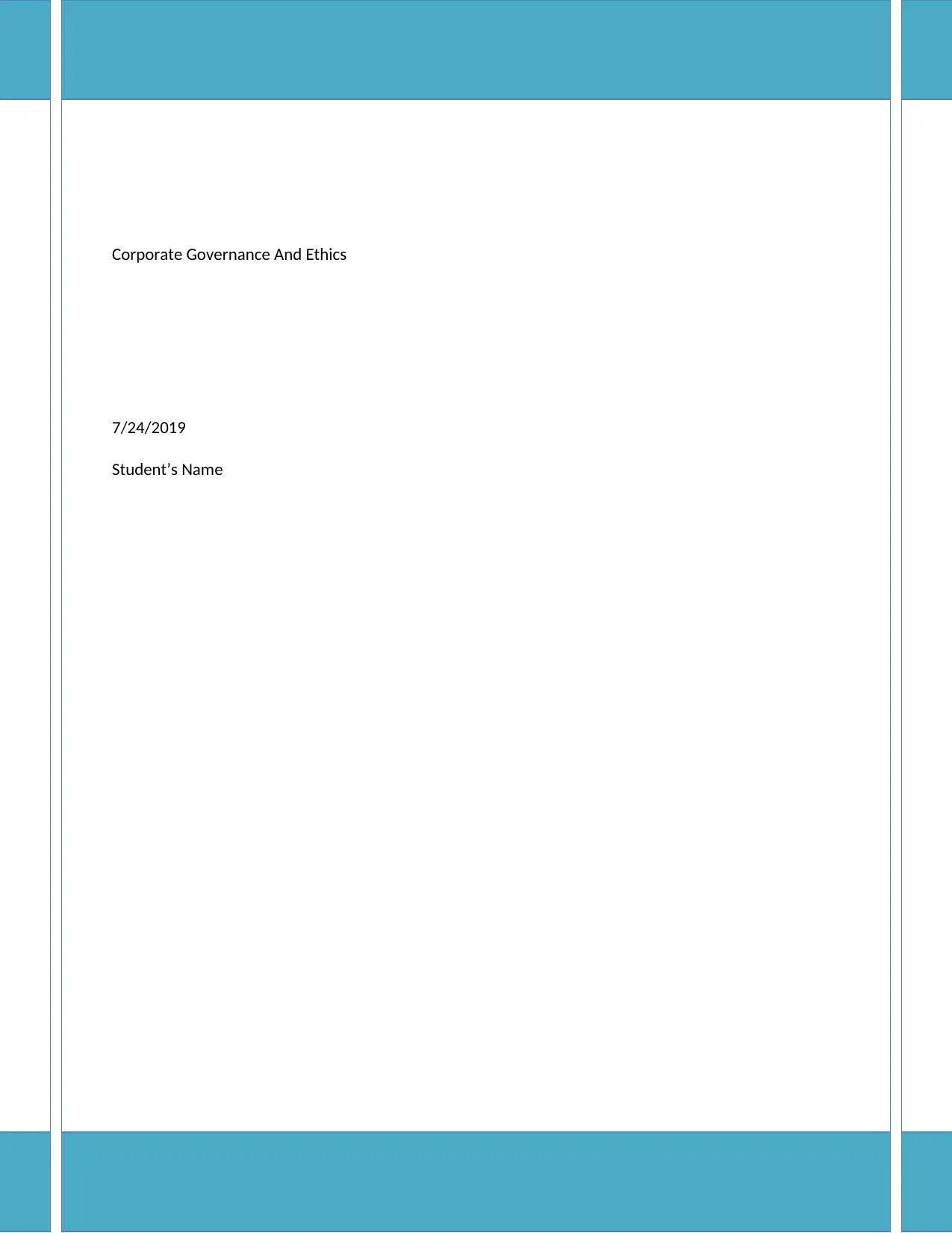
Running Head: BUSINESS AND CORPORATION LAW 0
Corporate Governance And Ethics
7/24/2019
Student’s Name
Corporate Governance And Ethics
7/24/2019
Student’s Name
Paraphrase This Document
Need a fresh take? Get an instant paraphrase of this document with our AI Paraphraser
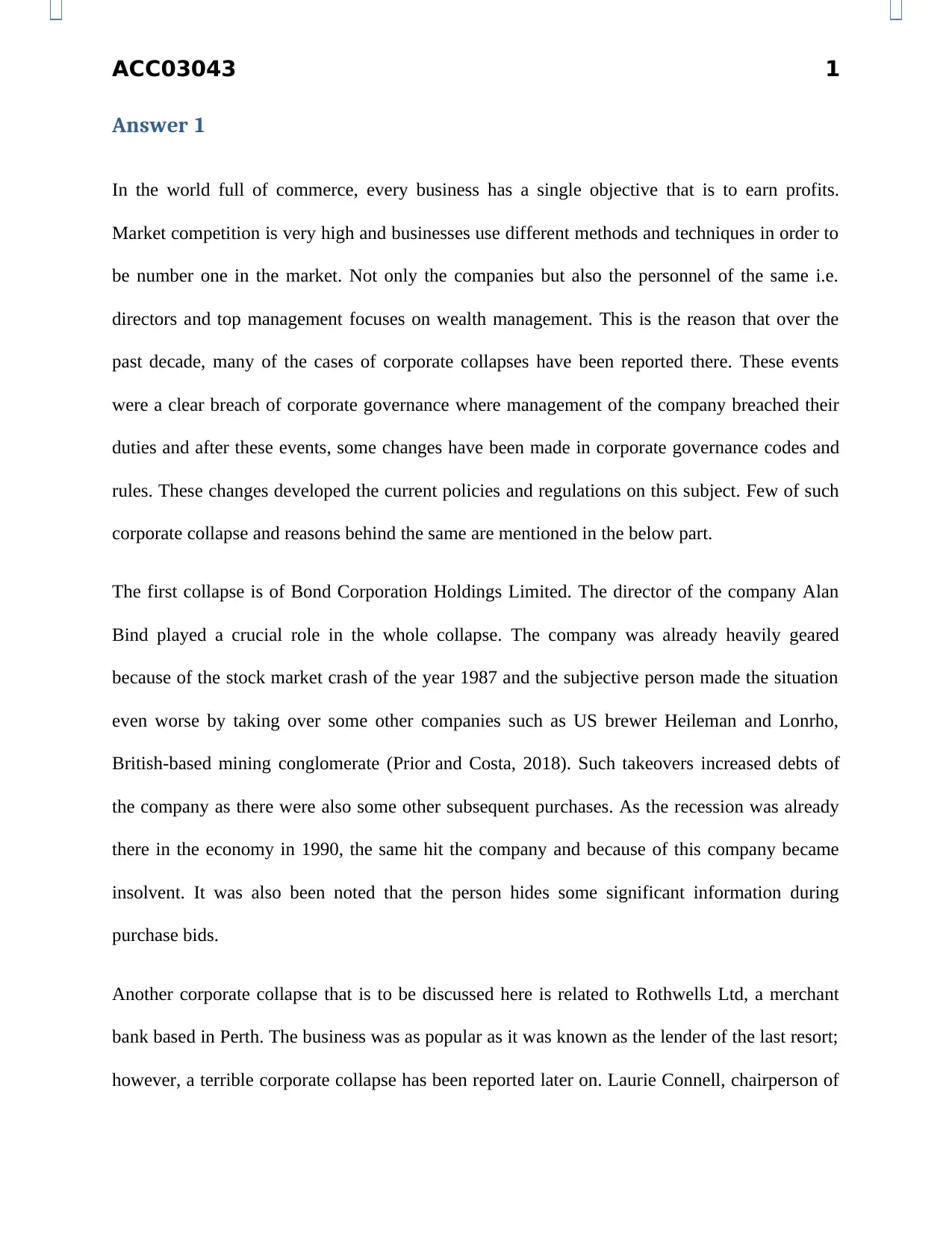
ACC03043 1
Answer 1
In the world full of commerce, every business has a single objective that is to earn profits.
Market competition is very high and businesses use different methods and techniques in order to
be number one in the market. Not only the companies but also the personnel of the same i.e.
directors and top management focuses on wealth management. This is the reason that over the
past decade, many of the cases of corporate collapses have been reported there. These events
were a clear breach of corporate governance where management of the company breached their
duties and after these events, some changes have been made in corporate governance codes and
rules. These changes developed the current policies and regulations on this subject. Few of such
corporate collapse and reasons behind the same are mentioned in the below part.
The first collapse is of Bond Corporation Holdings Limited. The director of the company Alan
Bind played a crucial role in the whole collapse. The company was already heavily geared
because of the stock market crash of the year 1987 and the subjective person made the situation
even worse by taking over some other companies such as US brewer Heileman and Lonrho,
British-based mining conglomerate (Prior and Costa, 2018). Such takeovers increased debts of
the company as there were also some other subsequent purchases. As the recession was already
there in the economy in 1990, the same hit the company and because of this company became
insolvent. It was also been noted that the person hides some significant information during
purchase bids.
Another corporate collapse that is to be discussed here is related to Rothwells Ltd, a merchant
bank based in Perth. The business was as popular as it was known as the lender of the last resort;
however, a terrible corporate collapse has been reported later on. Laurie Connell, chairperson of
Answer 1
In the world full of commerce, every business has a single objective that is to earn profits.
Market competition is very high and businesses use different methods and techniques in order to
be number one in the market. Not only the companies but also the personnel of the same i.e.
directors and top management focuses on wealth management. This is the reason that over the
past decade, many of the cases of corporate collapses have been reported there. These events
were a clear breach of corporate governance where management of the company breached their
duties and after these events, some changes have been made in corporate governance codes and
rules. These changes developed the current policies and regulations on this subject. Few of such
corporate collapse and reasons behind the same are mentioned in the below part.
The first collapse is of Bond Corporation Holdings Limited. The director of the company Alan
Bind played a crucial role in the whole collapse. The company was already heavily geared
because of the stock market crash of the year 1987 and the subjective person made the situation
even worse by taking over some other companies such as US brewer Heileman and Lonrho,
British-based mining conglomerate (Prior and Costa, 2018). Such takeovers increased debts of
the company as there were also some other subsequent purchases. As the recession was already
there in the economy in 1990, the same hit the company and because of this company became
insolvent. It was also been noted that the person hides some significant information during
purchase bids.
Another corporate collapse that is to be discussed here is related to Rothwells Ltd, a merchant
bank based in Perth. The business was as popular as it was known as the lender of the last resort;
however, a terrible corporate collapse has been reported later on. Laurie Connell, chairperson of
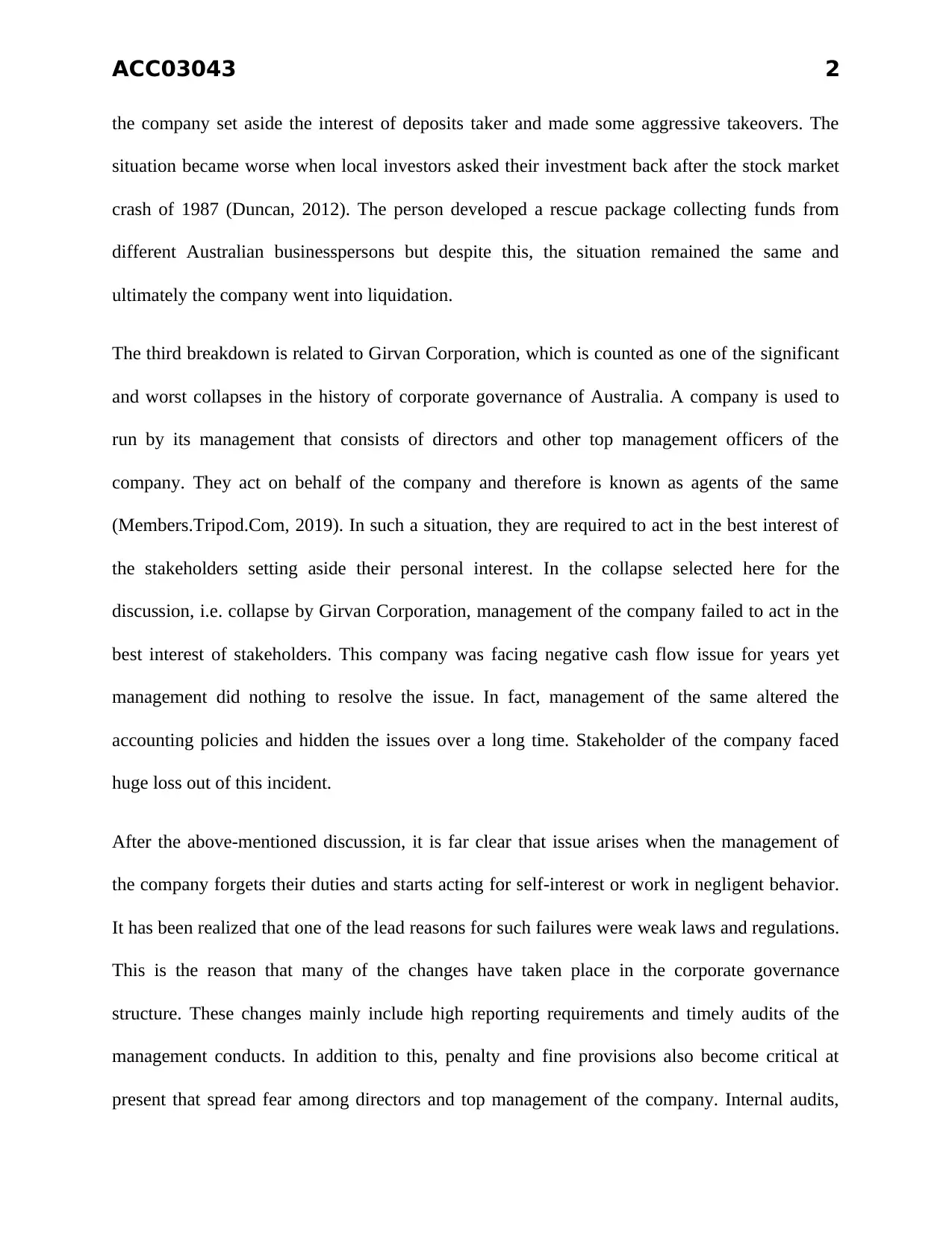
ACC03043 2
the company set aside the interest of deposits taker and made some aggressive takeovers. The
situation became worse when local investors asked their investment back after the stock market
crash of 1987 (Duncan, 2012). The person developed a rescue package collecting funds from
different Australian businesspersons but despite this, the situation remained the same and
ultimately the company went into liquidation.
The third breakdown is related to Girvan Corporation, which is counted as one of the significant
and worst collapses in the history of corporate governance of Australia. A company is used to
run by its management that consists of directors and other top management officers of the
company. They act on behalf of the company and therefore is known as agents of the same
(Members.Tripod.Com, 2019). In such a situation, they are required to act in the best interest of
the stakeholders setting aside their personal interest. In the collapse selected here for the
discussion, i.e. collapse by Girvan Corporation, management of the company failed to act in the
best interest of stakeholders. This company was facing negative cash flow issue for years yet
management did nothing to resolve the issue. In fact, management of the same altered the
accounting policies and hidden the issues over a long time. Stakeholder of the company faced
huge loss out of this incident.
After the above-mentioned discussion, it is far clear that issue arises when the management of
the company forgets their duties and starts acting for self-interest or work in negligent behavior.
It has been realized that one of the lead reasons for such failures were weak laws and regulations.
This is the reason that many of the changes have taken place in the corporate governance
structure. These changes mainly include high reporting requirements and timely audits of the
management conducts. In addition to this, penalty and fine provisions also become critical at
present that spread fear among directors and top management of the company. Internal audits,
the company set aside the interest of deposits taker and made some aggressive takeovers. The
situation became worse when local investors asked their investment back after the stock market
crash of 1987 (Duncan, 2012). The person developed a rescue package collecting funds from
different Australian businesspersons but despite this, the situation remained the same and
ultimately the company went into liquidation.
The third breakdown is related to Girvan Corporation, which is counted as one of the significant
and worst collapses in the history of corporate governance of Australia. A company is used to
run by its management that consists of directors and other top management officers of the
company. They act on behalf of the company and therefore is known as agents of the same
(Members.Tripod.Com, 2019). In such a situation, they are required to act in the best interest of
the stakeholders setting aside their personal interest. In the collapse selected here for the
discussion, i.e. collapse by Girvan Corporation, management of the company failed to act in the
best interest of stakeholders. This company was facing negative cash flow issue for years yet
management did nothing to resolve the issue. In fact, management of the same altered the
accounting policies and hidden the issues over a long time. Stakeholder of the company faced
huge loss out of this incident.
After the above-mentioned discussion, it is far clear that issue arises when the management of
the company forgets their duties and starts acting for self-interest or work in negligent behavior.
It has been realized that one of the lead reasons for such failures were weak laws and regulations.
This is the reason that many of the changes have taken place in the corporate governance
structure. These changes mainly include high reporting requirements and timely audits of the
management conducts. In addition to this, penalty and fine provisions also become critical at
present that spread fear among directors and top management of the company. Internal audits,
⊘ This is a preview!⊘
Do you want full access?
Subscribe today to unlock all pages.

Trusted by 1+ million students worldwide
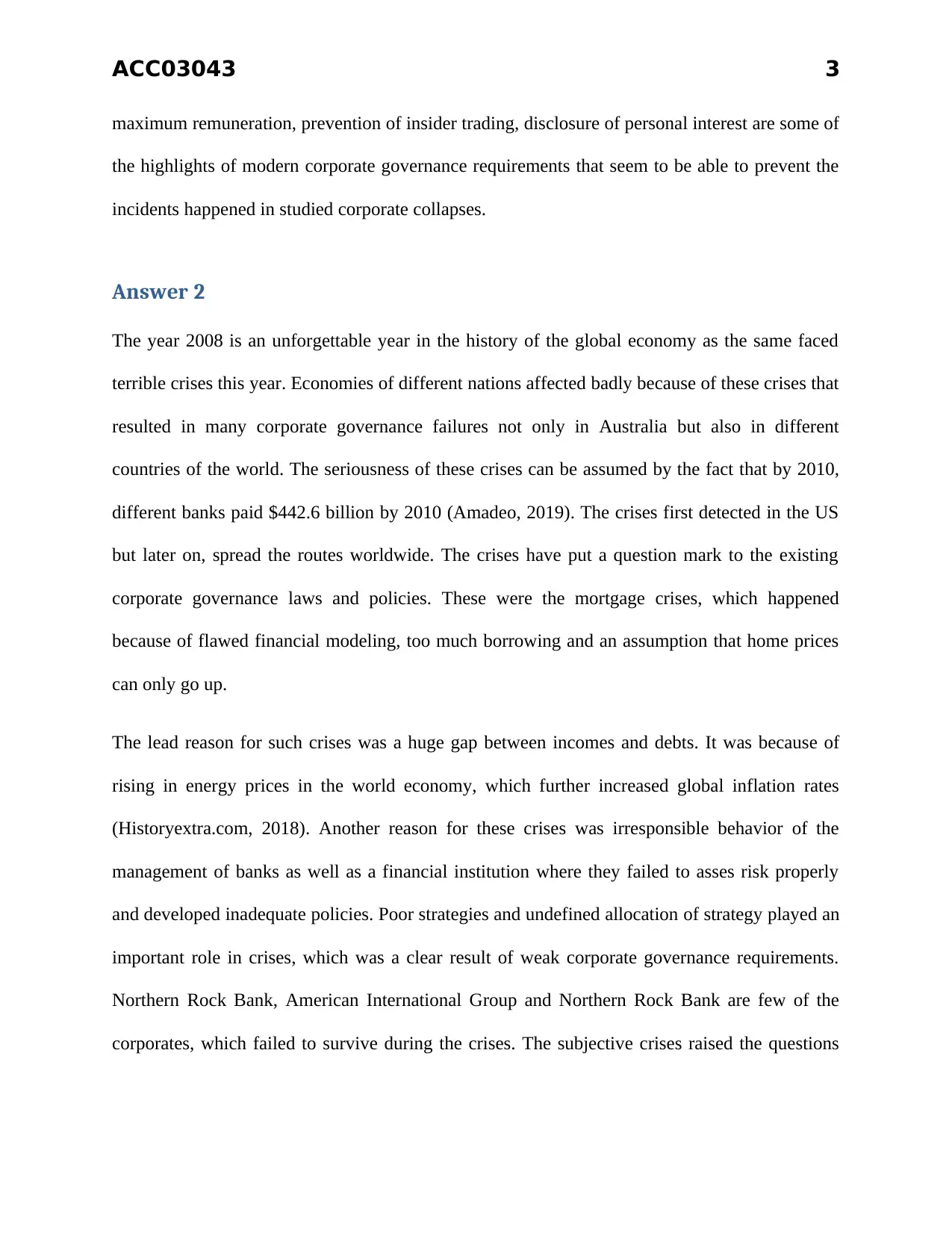
ACC03043 3
maximum remuneration, prevention of insider trading, disclosure of personal interest are some of
the highlights of modern corporate governance requirements that seem to be able to prevent the
incidents happened in studied corporate collapses.
Answer 2
The year 2008 is an unforgettable year in the history of the global economy as the same faced
terrible crises this year. Economies of different nations affected badly because of these crises that
resulted in many corporate governance failures not only in Australia but also in different
countries of the world. The seriousness of these crises can be assumed by the fact that by 2010,
different banks paid $442.6 billion by 2010 (Amadeo, 2019). The crises first detected in the US
but later on, spread the routes worldwide. The crises have put a question mark to the existing
corporate governance laws and policies. These were the mortgage crises, which happened
because of flawed financial modeling, too much borrowing and an assumption that home prices
can only go up.
The lead reason for such crises was a huge gap between incomes and debts. It was because of
rising in energy prices in the world economy, which further increased global inflation rates
(Historyextra.com, 2018). Another reason for these crises was irresponsible behavior of the
management of banks as well as a financial institution where they failed to asses risk properly
and developed inadequate policies. Poor strategies and undefined allocation of strategy played an
important role in crises, which was a clear result of weak corporate governance requirements.
Northern Rock Bank, American International Group and Northern Rock Bank are few of the
corporates, which failed to survive during the crises. The subjective crises raised the questions
maximum remuneration, prevention of insider trading, disclosure of personal interest are some of
the highlights of modern corporate governance requirements that seem to be able to prevent the
incidents happened in studied corporate collapses.
Answer 2
The year 2008 is an unforgettable year in the history of the global economy as the same faced
terrible crises this year. Economies of different nations affected badly because of these crises that
resulted in many corporate governance failures not only in Australia but also in different
countries of the world. The seriousness of these crises can be assumed by the fact that by 2010,
different banks paid $442.6 billion by 2010 (Amadeo, 2019). The crises first detected in the US
but later on, spread the routes worldwide. The crises have put a question mark to the existing
corporate governance laws and policies. These were the mortgage crises, which happened
because of flawed financial modeling, too much borrowing and an assumption that home prices
can only go up.
The lead reason for such crises was a huge gap between incomes and debts. It was because of
rising in energy prices in the world economy, which further increased global inflation rates
(Historyextra.com, 2018). Another reason for these crises was irresponsible behavior of the
management of banks as well as a financial institution where they failed to asses risk properly
and developed inadequate policies. Poor strategies and undefined allocation of strategy played an
important role in crises, which was a clear result of weak corporate governance requirements.
Northern Rock Bank, American International Group and Northern Rock Bank are few of the
corporates, which failed to survive during the crises. The subjective crises raised the questions
Paraphrase This Document
Need a fresh take? Get an instant paraphrase of this document with our AI Paraphraser
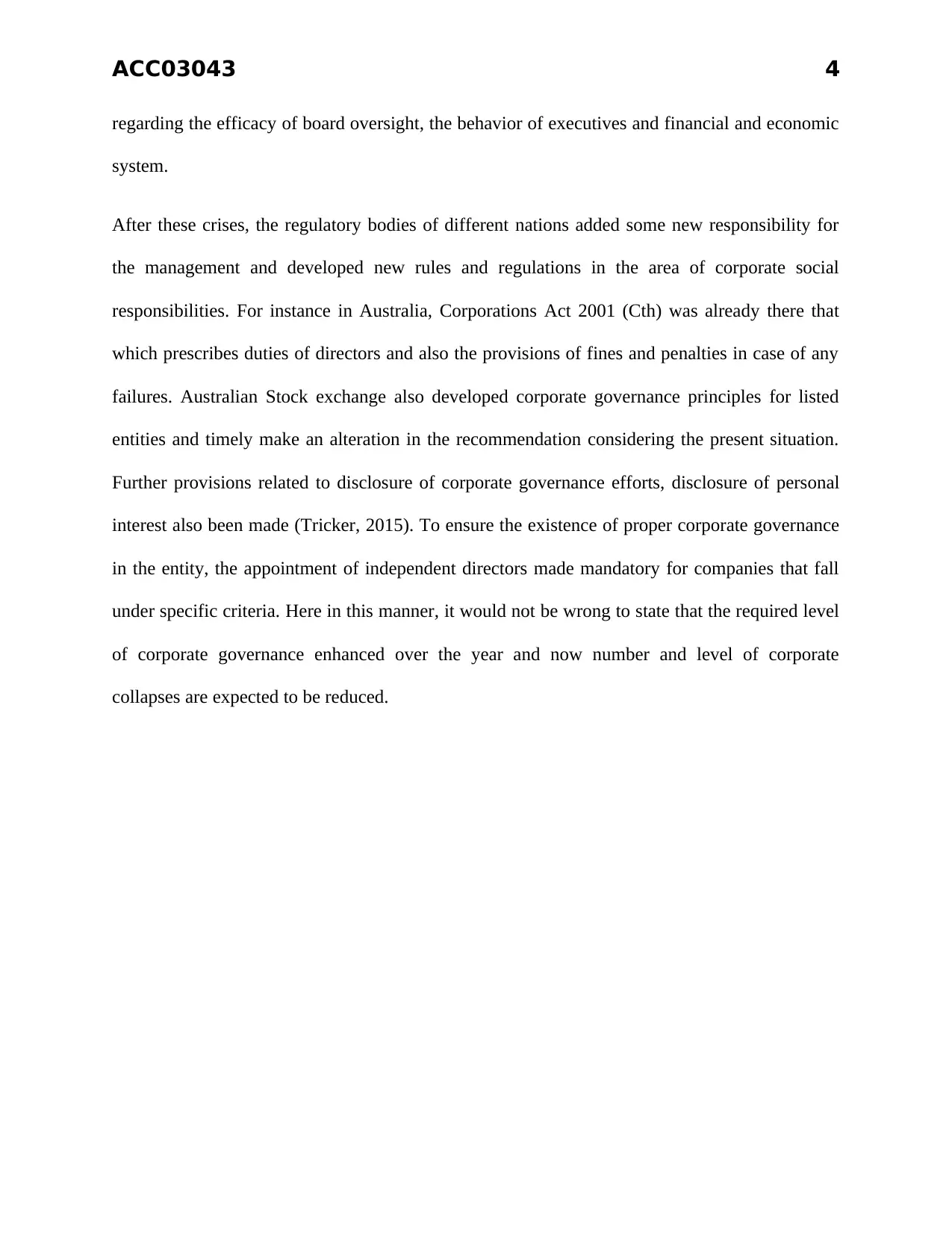
ACC03043 4
regarding the efficacy of board oversight, the behavior of executives and financial and economic
system.
After these crises, the regulatory bodies of different nations added some new responsibility for
the management and developed new rules and regulations in the area of corporate social
responsibilities. For instance in Australia, Corporations Act 2001 (Cth) was already there that
which prescribes duties of directors and also the provisions of fines and penalties in case of any
failures. Australian Stock exchange also developed corporate governance principles for listed
entities and timely make an alteration in the recommendation considering the present situation.
Further provisions related to disclosure of corporate governance efforts, disclosure of personal
interest also been made (Tricker, 2015). To ensure the existence of proper corporate governance
in the entity, the appointment of independent directors made mandatory for companies that fall
under specific criteria. Here in this manner, it would not be wrong to state that the required level
of corporate governance enhanced over the year and now number and level of corporate
collapses are expected to be reduced.
regarding the efficacy of board oversight, the behavior of executives and financial and economic
system.
After these crises, the regulatory bodies of different nations added some new responsibility for
the management and developed new rules and regulations in the area of corporate social
responsibilities. For instance in Australia, Corporations Act 2001 (Cth) was already there that
which prescribes duties of directors and also the provisions of fines and penalties in case of any
failures. Australian Stock exchange also developed corporate governance principles for listed
entities and timely make an alteration in the recommendation considering the present situation.
Further provisions related to disclosure of corporate governance efforts, disclosure of personal
interest also been made (Tricker, 2015). To ensure the existence of proper corporate governance
in the entity, the appointment of independent directors made mandatory for companies that fall
under specific criteria. Here in this manner, it would not be wrong to state that the required level
of corporate governance enhanced over the year and now number and level of corporate
collapses are expected to be reduced.
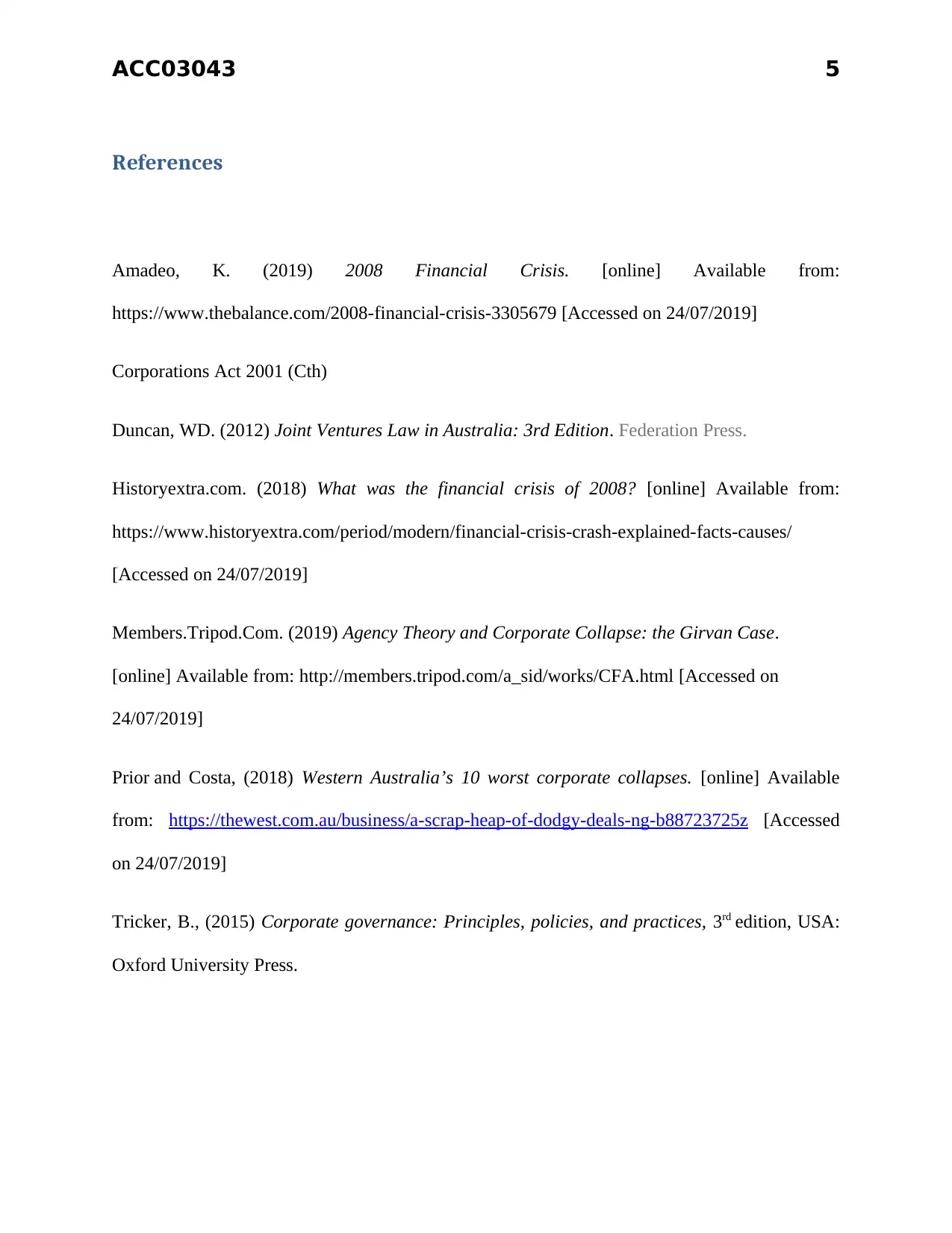
ACC03043 5
References
Amadeo, K. (2019) 2008 Financial Crisis. [online] Available from:
https://www.thebalance.com/2008-financial-crisis-3305679 [Accessed on 24/07/2019]
Corporations Act 2001 (Cth)
Duncan, WD. (2012) Joint Ventures Law in Australia: 3rd Edition. Federation Press.
Historyextra.com. (2018) What was the financial crisis of 2008? [online] Available from:
https://www.historyextra.com/period/modern/financial-crisis-crash-explained-facts-causes/
[Accessed on 24/07/2019]
Members.Tripod.Com. (2019) Agency Theory and Corporate Collapse: the Girvan Case.
[online] Available from: http://members.tripod.com/a_sid/works/CFA.html [Accessed on
24/07/2019]
Prior and Costa, (2018) Western Australia’s 10 worst corporate collapses. [online] Available
from: https://thewest.com.au/business/a-scrap-heap-of-dodgy-deals-ng-b88723725z [Accessed
on 24/07/2019]
Tricker, B., (2015) Corporate governance: Principles, policies, and practices, 3rd edition, USA:
Oxford University Press.
References
Amadeo, K. (2019) 2008 Financial Crisis. [online] Available from:
https://www.thebalance.com/2008-financial-crisis-3305679 [Accessed on 24/07/2019]
Corporations Act 2001 (Cth)
Duncan, WD. (2012) Joint Ventures Law in Australia: 3rd Edition. Federation Press.
Historyextra.com. (2018) What was the financial crisis of 2008? [online] Available from:
https://www.historyextra.com/period/modern/financial-crisis-crash-explained-facts-causes/
[Accessed on 24/07/2019]
Members.Tripod.Com. (2019) Agency Theory and Corporate Collapse: the Girvan Case.
[online] Available from: http://members.tripod.com/a_sid/works/CFA.html [Accessed on
24/07/2019]
Prior and Costa, (2018) Western Australia’s 10 worst corporate collapses. [online] Available
from: https://thewest.com.au/business/a-scrap-heap-of-dodgy-deals-ng-b88723725z [Accessed
on 24/07/2019]
Tricker, B., (2015) Corporate governance: Principles, policies, and practices, 3rd edition, USA:
Oxford University Press.
⊘ This is a preview!⊘
Do you want full access?
Subscribe today to unlock all pages.

Trusted by 1+ million students worldwide
1 out of 6
Related Documents
Your All-in-One AI-Powered Toolkit for Academic Success.
+13062052269
info@desklib.com
Available 24*7 on WhatsApp / Email
![[object Object]](/_next/static/media/star-bottom.7253800d.svg)
Unlock your academic potential
Copyright © 2020–2025 A2Z Services. All Rights Reserved. Developed and managed by ZUCOL.





